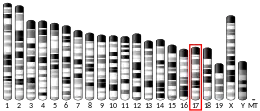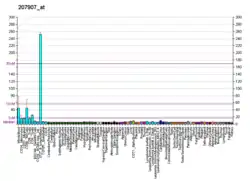LIGHT, also known as tumor necrosis factor superfamily member 14 (TNFSF14), is a secreted protein of the TNF superfamily.[5][6][7] It is recognized by herpesvirus entry mediator (HVEM), as well as decoy receptor 3.
Nomenclature
LIGHT stands for "homologous to lymphotoxin, exhibits inducible expression and competes with HSV glycoprotein D for binding to herpesvirus entry mediator, a receptor expressed on T lymphocytes". In the cluster of differentiation terminology it is classified as CD258.
Function
The protein encoded by this gene is a member of the tumor necrosis factor (TNF) ligand family. This protein is a ligand for TNFRSF14, which is a member of the tumor necrosis factor receptor superfamily, and which is also known as a herpesvirus entry mediator (HVEM). Two alternatively spliced transcript variant encoding distinct isoforms have been reported.[6]
This protein may function as a costimulatory factor for the activation of lymphoid cells and as a deterrent to infection by herpesvirus. This protein has been shown to stimulate the proliferation of T cells,[8] trigger apoptosis of various tumor cells[9] and play a role in vascular normalisation processes.[10] This protein is also reported to prevent tumor necrosis factor alpha-mediated apoptosis in primary hepatocytes.[11]
Interactions
LIGHT has been shown to interact with TNFRSF14,[12][13] TNFRSF6B,[12][13][14] BIRC2,[15] TRAF2[15] and TRAF3.[15]
Role in herpes simplex virus
Similar to how CD4 is the primary mediating receptor in HIV infection, the HSV glycoprotein (gD) binds to the HVEM receptor which is demanded by TNFSF14/LIGHT lowering the ability for LIGHT to activate the NFκB pathway. NFκB is a survival factor helping to inhibit apoptosis which triggers a pathway inhibiting caspase 8. When gD from HSV binds to HVEM, LIGHT is non-competitively inhibited from binding, encouraging apoptosis in the infected cell.[7]
References
- 1 2 3 GRCh38: Ensembl release 89: ENSG00000125735 - Ensembl, May 2017
- 1 2 3 GRCm38: Ensembl release 89: ENSMUSG00000005824 - Ensembl, May 2017
- ↑ "Human PubMed Reference:". National Center for Biotechnology Information, U.S. National Library of Medicine.
- ↑ "Mouse PubMed Reference:". National Center for Biotechnology Information, U.S. National Library of Medicine.
- ↑ Mauri DN, Ebner R, Montgomery RI, Kochel KD, Cheung TC, Yu GL, Ruben S, Murphy M, Eisenberg RJ, Cohen GH, Spear PG, Ware CF (January 1998). "LIGHT, a new member of the TNF superfamily, and lymphotoxin alpha are ligands for herpesvirus entry mediator". Immunity. 8 (1): 21–30. doi:10.1016/S1074-7613(00)80455-0. PMID 9462508.
- 1 2 "Entrez Gene: TNFSF14 tumor necrosis factor (ligand) superfamily, member 14".
- 1 2 Ware, Carl (2008). "Chapter 25: TNF-Related Cytokines in Immunity". In Paul, William (ed.). Fundamental Immunology (Book) (6th ed.). Philadelphia: Lippincott Williams & Wilkins. pp. 776–801. ISBN 978-0-7817-6519-0.
- ↑ Tamada, K; Shimozaki, K; Chapoval, AI; Zhai, Y; Su, J; Chen, SF; Hsieh, SL; Nagata, S; Ni, J; Chen, L (15 April 2000). "LIGHT, a TNF-like molecule, costimulates T cell proliferation and is required for dendritic cell-mediated allogeneic T cell response". Journal of Immunology. 164 (8): 4105–10. doi:10.4049/jimmunol.164.8.4105. PMID 10754304. S2CID 32066617.
- ↑ Rooney, IA; Butrovich, KD; Glass, AA; Borboroglu, S; Benedict, CA; Whitbeck, JC; Cohen, GH; Eisenberg, RJ; Ware, CF (12 May 2000). "The lymphotoxin-beta receptor is necessary and sufficient for LIGHT-mediated apoptosis of tumor cells". The Journal of Biological Chemistry. 275 (19): 14307–15. doi:10.1074/jbc.275.19.14307. PMID 10799510.
- ↑ He, B; Jabouille, A; Steri, V; Johansson-Percival, A; Michael, IP; Kotamraju, VR; Junckerstorff, R; Nowak, AK; Hamzah, J; Lee, G; Bergers, G; Ganss, R (June 2018). "Vascular targeting of LIGHT normalizes blood vessels in primary brain cancer and induces intratumoural high endothelial venules". The Journal of Pathology. 245 (2): 209–221. doi:10.1002/path.5080. PMC 6737176. PMID 29603739.
- ↑ Matsui, H; Hikichi, Y; Tsuji, I; Yamada, T; Shintani, Y (20 December 2002). "LIGHT, a member of the tumor necrosis factor ligand superfamily, prevents tumor necrosis factor-alpha-mediated human primary hepatocyte apoptosis, but not Fas-mediated apoptosis". The Journal of Biological Chemistry. 277 (51): 50054–61. doi:10.1074/jbc.M206562200. PMID 12393901.
- 1 2 Zhang J, Salcedo TW, Wan X, Ullrich S, Hu B, Gregorio T, Feng P, Qi S, Chen H, Cho YH, Li Y, Moore PA, Wu J (June 2001). "Modulation of T-cell responses to alloantigens by TR6/DcR3". The Journal of Clinical Investigation. 107 (11): 1459–68. doi:10.1172/JCI12159. PMC 209323. PMID 11390428.
- 1 2 Yu KY, Kwon B, Ni J, Zhai Y, Ebner R, Kwon BS (May 1999). "A newly identified member of tumor necrosis factor receptor superfamily (TR6) suppresses LIGHT-mediated apoptosis". The Journal of Biological Chemistry. 274 (20): 13733–6. doi:10.1074/jbc.274.20.13733. PMID 10318773.
- ↑ Hsu TL, Chang YC, Chen SJ, Liu YJ, Chiu AW, Chio CC, Chen L, Hsieh SL (May 2002). "Modulation of dendritic cell differentiation and maturation by decoy receptor 3". Journal of Immunology. 168 (10): 4846–53. doi:10.4049/jimmunol.168.10.4846. PMID 11994433.
- 1 2 3 Kuai J, Nickbarg E, Wooters J, Qiu Y, Wang J, Lin LL (April 2003). "Endogenous association of TRAF2, TRAF3, cIAP1, and Smac with lymphotoxin beta receptor reveals a novel mechanism of apoptosis". The Journal of Biological Chemistry. 278 (16): 14363–9. doi:10.1074/jbc.M208672200. PMID 12571250.
Further reading
- Yang D, Zhai Y, Zhang M (2003). "LIGHT, a new member of the TNF superfamily". Journal of Biological Regulators and Homeostatic Agents. 16 (3): 206–10. PMID 12456019.
- Bénichou S, Benmerah A (January 2003). "[The HIV nef and the Kaposi-sarcoma-associated virus K3/K5 proteins: "parasites"of the endocytosis pathway]". Médecine/Sciences. 19 (1): 100–6. doi:10.1051/medsci/2003191100. PMID 12836198.
- Anderson JL, Hope TJ (April 2004). "HIV accessory proteins and surviving the host cell". Current HIV/AIDS Reports. 1 (1): 47–53. doi:10.1007/s11904-004-0007-x. PMID 16091223. S2CID 34731265.
- Marsters SA, Sheridan JP, Pitti RM, Brush J, Goddard A, Ashkenazi A (April 1998). "Identification of a ligand for the death-domain-containing receptor Apo3". Current Biology. 8 (9): 525–8. doi:10.1016/S0960-9822(98)70204-0. PMID 9560343. S2CID 14953579.
- Zhai Y, Guo R, Hsu TL, Yu GL, Ni J, Kwon BS, Jiang GW, Lu J, Tan J, Ugustus M, Carter K, Rojas L, Zhu F, Lincoln C, Endress G, Xing L, Wang S, Oh KO, Gentz R, Ruben S, Lippman ME, Hsieh SL, Yang D (September 1998). "LIGHT, a novel ligand for lymphotoxin beta receptor and TR2/HVEM induces apoptosis and suppresses in vivo tumor formation via gene transfer". The Journal of Clinical Investigation. 102 (6): 1142–51. doi:10.1172/JCI3492. PMC 509097. PMID 9739048.
- Harrop JA, McDonnell PC, Brigham-Burke M, Lyn SD, Minton J, Tan KB, Dede K, Spampanato J, Silverman C, Hensley P, DiPrinzio R, Emery JG, Deen K, Eichman C, Chabot-Fletcher M, Truneh A, Young PR (October 1998). "Herpesvirus entry mediator ligand (HVEM-L), a novel ligand for HVEM/TR2, stimulates proliferation of T cells and inhibits HT29 cell growth". The Journal of Biological Chemistry. 273 (42): 27548–56. doi:10.1074/jbc.273.42.27548. PMID 9765287.
- Yu KY, Kwon B, Ni J, Zhai Y, Ebner R, Kwon BS (May 1999). "A newly identified member of tumor necrosis factor receptor superfamily (TR6) suppresses LIGHT-mediated apoptosis". The Journal of Biological Chemistry. 274 (20): 13733–6. doi:10.1074/jbc.274.20.13733. PMID 10318773.
- Rooney IA, Butrovich KD, Glass AA, Borboroglu S, Benedict CA, Whitbeck JC, Cohen GH, Eisenberg RJ, Ware CF (May 2000). "The lymphotoxin-beta receptor is necessary and sufficient for LIGHT-mediated apoptosis of tumor cells". The Journal of Biological Chemistry. 275 (19): 14307–15. doi:10.1074/jbc.275.19.14307. PMID 10799510.
- Lama J, Ware CF (October 2000). "Human immunodeficiency virus type 1 Nef mediates sustained membrane expression of tumor necrosis factor and the related cytokine LIGHT on activated T cells". Journal of Virology. 74 (20): 9396–402. doi:10.1128/JVI.74.20.9396-9402.2000. PMC 112368. PMID 11000208.
- Morel Y, Schiano de Colella JM, Harrop J, Deen KC, Holmes SD, Wattam TA, Khandekar SS, Truneh A, Sweet RW, Gastaut JA, Olive D, Costello RT (October 2000). "Reciprocal expression of the TNF family receptor herpes virus entry mediator and its ligand LIGHT on activated T cells: LIGHT down-regulates its own receptor". Journal of Immunology. 165 (8): 4397–404. doi:10.4049/jimmunol.165.8.4397. PMID 11035077.
- Zhang J, Salcedo TW, Wan X, Ullrich S, Hu B, Gregorio T, Feng P, Qi S, Chen H, Cho YH, Li Y, Moore PA, Wu J (June 2001). "Modulation of T-cell responses to alloantigens by TR6/DcR3". The Journal of Clinical Investigation. 107 (11): 1459–68. doi:10.1172/JCI12159. PMC 209323. PMID 11390428.
- Granger SW, Butrovich KD, Houshmand P, Edwards WR, Ware CF (November 2001). "Genomic characterization of LIGHT reveals linkage to an immune response locus on chromosome 19p13.3 and distinct isoforms generated by alternate splicing or proteolysis". Journal of Immunology. 167 (9): 5122–8. doi:10.4049/jimmunol.167.9.5122. PMID 11673523.
- Shaikh RB, Santee S, Granger SW, Butrovich K, Cheung T, Kronenberg M, Cheroutre H, Ware CF (December 2001). "Constitutive expression of LIGHT on T cells leads to lymphocyte activation, inflammation, and tissue destruction". Journal of Immunology. 167 (11): 6330–7. doi:10.4049/jimmunol.167.11.6330. PMID 11714797.
- Bobik A, Kalinina N (December 2001). "Tumor necrosis factor receptor and ligand superfamily family members TNFRSF14 and LIGHT: new players in human atherogenesis". Arteriosclerosis, Thrombosis, and Vascular Biology. 21 (12): 1873–5. doi:10.1161/atvb.21.12.1873. PMID 11742858.
- Wang J, Lo JC, Foster A, Yu P, Chen HM, Wang Y, Tamada K, Chen L, Fu YX (December 2001). "The regulation of T cell homeostasis and autoimmunity by T cell-derived LIGHT". The Journal of Clinical Investigation. 108 (12): 1771–80. doi:10.1172/JCI13827. PMC 209470. PMID 11748260.
- Hsu TL, Chang YC, Chen SJ, Liu YJ, Chiu AW, Chio CC, Chen L, Hsieh SL (May 2002). "Modulation of dendritic cell differentiation and maturation by decoy receptor 3". Journal of Immunology. 168 (10): 4846–53. doi:10.4049/jimmunol.168.10.4846. PMID 11994433.
- Castellano R, Van Lint C, Peri V, Veithen E, Morel Y, Costello R, Olive D, Collette Y (November 2002). "Mechanisms regulating expression of the tumor necrosis factor-related light gene. Role of calcium-signaling pathway in the transcriptional control". The Journal of Biological Chemistry. 277 (45): 42841–51. doi:10.1074/jbc.M207689200. PMID 12215452.
- Matsui H, Hikichi Y, Tsuji I, Yamada T, Shintani Y (December 2002). "LIGHT, a member of the tumor necrosis factor ligand superfamily, prevents tumor necrosis factor-alpha-mediated human primary hepatocyte apoptosis, but not Fas-mediated apoptosis". The Journal of Biological Chemistry. 277 (51): 50054–61. doi:10.1074/jbc.M206562200. PMID 12393901.
External links
- TNFSF14+protein,+human at the U.S. National Library of Medicine Medical Subject Headings (MeSH)
This article incorporates text from the United States National Library of Medicine, which is in the public domain.




